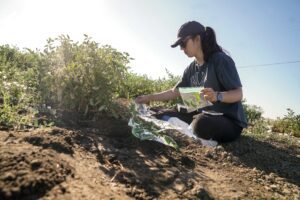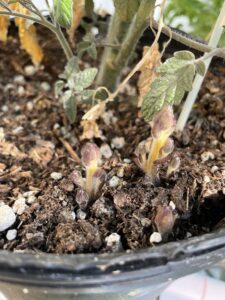Sep 27, 2023Parasitic weeds threaten California processing tomatoes
From the sky, in laboratories and underground, University of California, Davis, researchers are working to detect, manage and fight a parasitic weed threatening the state’s processing tomato industry.
At first glance, orobanche ramosa looks like an interesting blossoming plant, one that could add a unique flair to flower arrangements. But it’s a parasitic weed that attaches to roots, sucks out nutrients and is threatening California’s lucrative $1.5 billion processing tomato industry.
The weed’s tiny seeds — smaller than finely ground pepper — can survive in soil for many decades and be carried by wind, water, soil transfers and even footwear. If found attached to crop plants and reported to the state, farmers are required to destroy the field before harvest, taking large losses not covered by crop insurance.


Its resurgence is concern for state regulators and industry, which is helping fund multidisciplinary research at UC Davis on ways to detect, manage and fight the weed.
“Most of the damage occurs before you can see it,” said Brad Hanson, a professor of Cooperative Extension in plant sciences, who is involved in much of the orobanche research at UC Davis. “There’s a lot of ripples to the problem. We could see it spread to other crops and other regions in the state if it’s not managed.”
Across three colleges at UC Davis, researchers are working on ways to detect the pest, manage it in the field throughout its life cycle and develop long-term solutions to minimize the threat to California agriculture. The work is happening in labs and the field, using drones, human spotters and new techniques to sniff out volatile organic chemicals that are emitted when the weed is present.
They are also testing ways to sanitize farm equipment to reduce the risk of spreading seeds from contaminated fields to clean ones. And they are testing dozens of other crops to see if they are susceptible or could be used as false hosts to kill off the orobanche seeds in the soil.
At high infestation levels, orobanche can reduce crop yields by as much as 80%, which is a tremendous threat considering California farmers grow roughly 95% of all processed tomatoes — for pizza sauce, soups, tomato paste — in the nation.
“Believing it to be eradicated, the industry moved on to other challenges,” said Zach Bagley, managing director for the California Tomato Research Institute Inc. (CTRI). “We’ve been aggressive, with this as our top priority, and we’ve been putting the funding behind it.”
CTRI’s research budget for 2022 and 2023 is nearly $1 million, and half of that money has gone to fund six researchers and their teams at UC Davis and UC Davis Chile, as well as some work at University of Wisconsin.
“Unfortunately, or fortunately, tomatoes are going to have to be the tip on the spear of trying to address this,” Bagley said. “UC Davis has relationships with industry. They have the expertise in the areas we need for this problem.”
Last year, CTRI, Corteva and Hanson’s team got state permission for an herbicide treatment that, in trials, has reduced orobanche emergence fourfold. “That management treatment has been used extensively by growers this year,” Bagley said.


It’s hard to know quite how far orobanche has spread.
Yolo County farmers reported 71 to 403 acres affected between 2017 and 2022, with some years seeing less and others more. No cases have been reported this year, Yolo County Agriculture Commissioner Humberto Izquierdo said.
But orobanche weeds could be sprouting up elsewhere.
“The issue with this pest is that growers are very reluctant to report it and it’s not an easy issue to spot,” Izquierdo said. “The regulatory requirements are very strict. Once it’s found, we limit harvesting on that field.”
The weed is considered a quarantine pest in California and because of that, crops must be destroyed once a case is reported and no susceptible crops can be planted for two years. Agriculture commissioners can also quarantine fields up to a mile away.
Izquierdo works with canneries and the CTRI to promote good sanitation policies, so the weeds don’t spread. But with a limited number of inspectors, it’s hard to get a handle on the extent of the problem without consistent reporting.
Hanson says it’s likely that there are more infested fields in Yolo County than what has been reported, and there’s no obvious reason orobanche could not spread to other tomato-producing regions. But the harsh repercussions for reporting can be a barrier: “Do the right thing, lose hundreds of thousands of dollars,” he said.
For Hanson, the research is among the most collaborative that he’s been a part of and shows how real-world problems can be addressed when industry, regulators and researchers work together.
“We’re making progress on a major threat to California agriculture,” he said, “and it’s really rewarding to be a part of the research team.”














